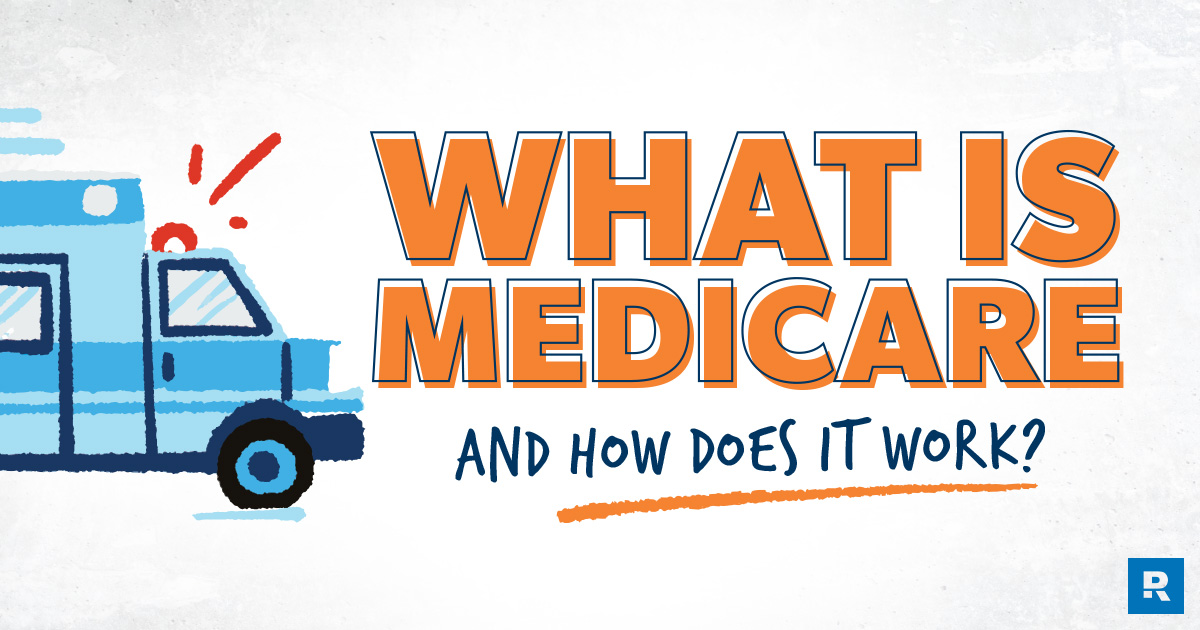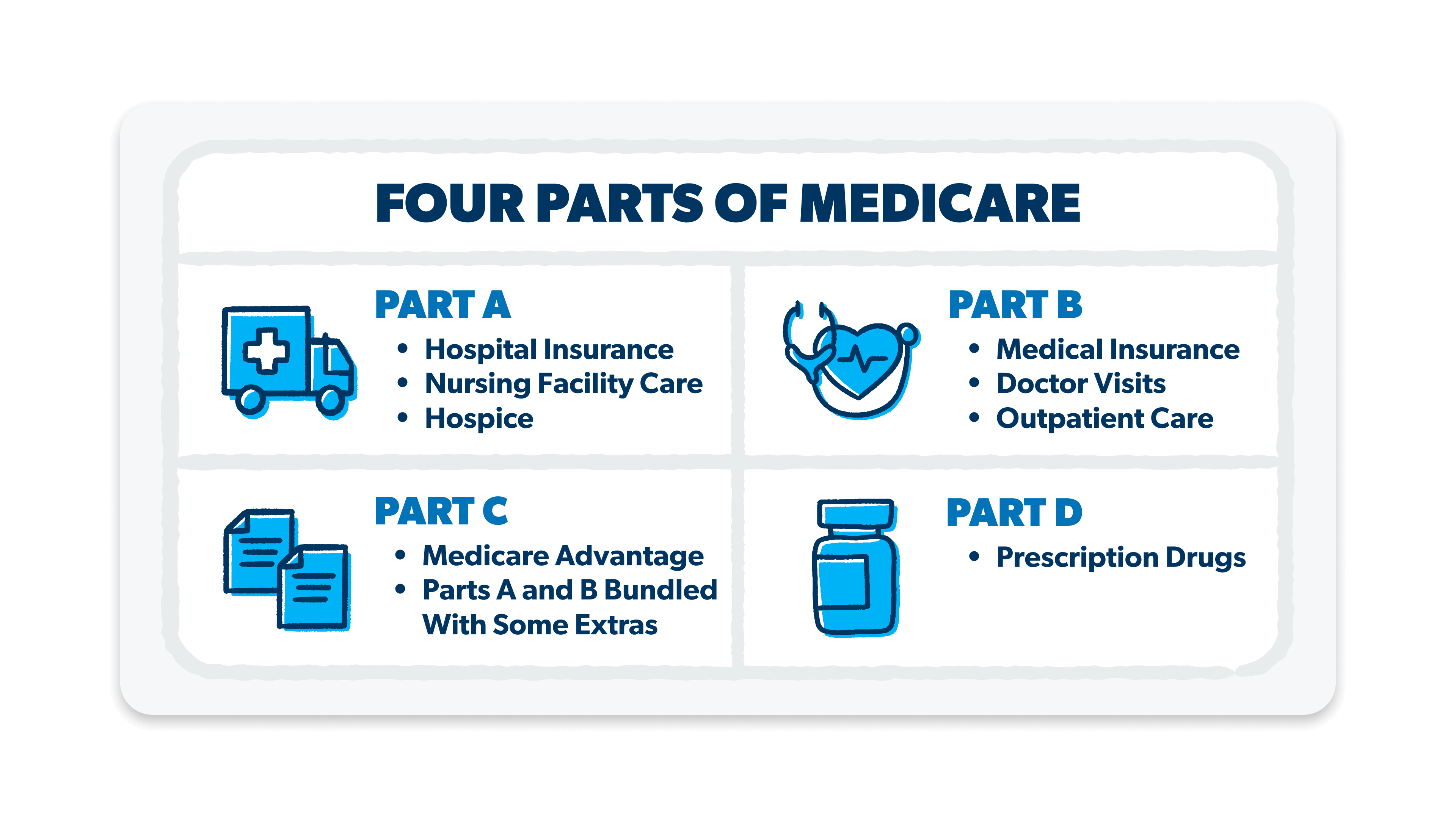
You’ve reached your golden years. You’ve got a lot of life under your belt and wisdom under your hat. Things should be easier now.
So, why does this dang Medicare feel so confusing?
Well, it was created by the government so that might be your first clue. And second, it’s just a lot to understand. But we’re going to walk through it and explain everything you need to know about Medicare so you can start making informed choices and get back to learning about TikTok from your grandkids.
Key Takeaways
- Medicare is a federal government-run health insurance program for people 65 and older. It was created to help people who are no longer working get health insurance.
- Medicare coverage is separated into parts: Part A for hospital coverage, Part B for visits to doctors and other providers, and Part D for drug coverage.
- You have two Medicare plan options: Original Medicare (gives you more control) and Medicare Advantage (less control).
- Most people find Original Medicare alone doesn’t give them enough coverage and sign up for Medicare supplemental insurance too.
What Is Medicare?
Let’s be real—you probably have an idea of what Medicare is. (Maybe you saw Jim’s post on Amy’s Facebook photo about how he just signed up for Parts A and B but isn’t sure isn’t sure if he needs Medigap.) But we’ll go ahead and answer the question What is Medicare? anyway. Medicare is a health insurance program established by the federal government for people 65 and older and folks with certain disabilities.
Do you have the right health insurance coverage? Connect with a Trusted pro today.
While they’re working, most people get their health insurance through their employer because it’s more affordable. But once you retire, coverage gets very expensive. The government created Medicare as an option for those people.
They describe it as a fee-for-service program. Whenever you need services, you pay for a portion of the cost—much like with regular health insurance deductibles and copays.
As a government program, Medicare has worked out discounted costs with any provider that accepts Medicare patients. That means the Medicare-approved amount (price) for services will be lower than you’d see with regular, private health insurance.
How Does Medicare Work?
Unlike regular health insurance, Medicare doesn’t have plans for couples or families—it only covers individuals. Medicare comes in what are called “parts”—Part A, Part B, Part D, and then a Medicare supplement. Each part is like a little mini plan that helps cover a different aspect of health care.
You can enroll for Medicare when you turn 65 during your Initial Enrollment Period or any year after that during a General Enrollment Period from January 1–March 31.
Like we mentioned above, one way Medicare keeps costs down is by offering a Medicare-approved price for services. That means if you have Medicare, you’ll pay less for your medical care than someone with regular health insurance would pay. Not all doctors and providers will accept the Medicare-approved amount though. So you have to find the ones who do.
There are two versions of Medicare available: Original Medicare and Medicare Advantage. We’ll go more into these later. First we’re going to get into who qualifies and the different parts of Medicare. And if this already has you feeling overwhelmed, don’t worry. There are folks who can help walk you through all the decisions you have to make.
Medicare Tips That Set You Up for Success
Government programs are the best . . . at being confusing. And Medicare is no exception. But you can download a guide that makes learning the basics of Medicare feel like talking to a no-nonsense friend over coffee.
Who Qualifies for Medicare?
Remember, age is just a number. But it’s also the difference between whether you qualify for Medicare or not. Americans 65 and older are eligible for Medicare. You’re also eligible for restaurant discounts and tired eyes as your grandkids beg you to read book #157. Just some of the great things about turning 65.
Other folks who qualify for Medicare are people with disabilities, end-stage renal disease (which is where you need dialysis or a kidney transplant), or ALS (aka Lou Gehrig’s disease).
What Are the Parts of Medicare?
Like we mentioned earlier, Medicare is made up of different parts that act like mini plans covering different medical services. Depending on whether you get Original Medicare or a Medicare Advantage plan, you either have to sign up for each one separately or they’ll come in one big plan.
Part A
Part A is a hospital insurance plan that covers inpatient hospital visits (like when you have to stay overnight) and care received at a skilled nursing facility or hospice and at home.
Part B
Part B is for medical services like doctor visits and outpatient care. It covers:
- Doctor visits and services from other health care providers
- Outpatient care
- Home health care
- Durable medical equipment (DME) like wheelchairs, hospital beds, oxygen tanks and walkers
- Lots of preventative services like screenings, shots and annual wellness visits
Part D
This one’s easy to remember because “D” is for drugs. Remember, do drugs—but only if you have Medicare Part D (and only if your doctor prescribed them)! You have to add Part D separately if you’ve got Original Medicare, but Medicare Advantage plans come with drugs included.
Along with helping cover the cost of prescription drugs, Part D also helps with the cost of many recommended shots and vaccines.

Medicare Supplemental Insurance
Now, something you may have noticed as we’ve talked about all these different aspects of Medicare is wording like helps cover and covers many. That’s because Medicare doesn’t pay for everything, and many people find themselves needing more coverage. (Sad trombone.)
Private companies have created Medicare Supplemental Insurance (also called Medigap) as extra insurance you can purchase to help pay for your share of health care costs if you have Original Medicare. Most people with Original Medicare need this. If you choose to get a Medigap plan, you'll pay a premium for this and another for Medicare Part B.
What Are Your Medicare Options?
While it adds to the confusion, having multiple options means there’s a better chance you can find something that works well for you. With Medicare, you have two main options: one from the government and one from private companies. (And by the way, you can't have both—if you choose Original Medicare with a Medigap plan, you can't also get a Medicare Advantage plan.)
Original Medicare
Original Medicare is offered by the government. It basically refers to Parts A and B. Part A is free and Part B has a premium. You get a separate insurance card for each part. It renews automatically every year so unless you want to change your coverage, you’re good to go.
It covers a large portion of approved medical expenses, but you will still have to pay out-of-pocket to make up the difference after you meet your deductible. Regular health insurance usually has a yearly limit on what you’ll pay out-of-pocket, but Original Medicare does not.
With Original Medicare, you can go to any doctor, hospital or provider who takes Medicare, and you don’t usually need a referral to see a specialist.
If you want drug coverage, you’ll need to add on Part D (this usually renews automatically).
But as we’ve mentioned, Original Medicare is not enough coverage for most people, so they add Medicare supplement insurance.
Medicare Advantage
You may have been wondering as we went along, Part A, Part B, Part D . . . where is Part C? Well, here it is. Medicare Advantage is known as Part C. Don’t ask us why.
With Medicare Advantage, you get all the parts bundled into one plan—and some plans even cover things like vision, hearing and dental services. Medicare Advantage plans are offered through private insurance companies.
Most plans include drug coverage (Part D). There is also a yearly limit to how much you’ll pay out-of-pocket. How much you’ll pay out-of-pocket for services though is different with each service. It could be higher or lower than the Medicare-approved price.
Whether your plan automatically renews or not depends on the plan. You may have to re-enroll every year.
When it comes to which providers you can use, Medicare Advantage is more like traditional health insurance. You are limited to providers who are within the plan’s network. You also may need a referral before you can see a specialist. This means the insurance company running your advantage plan could deny you the specialist referral and you’d have to pay for the whole thing out-of-pocket.
Because you only have one insurance card on an advantage plan, it sounds simpler. But it’s not really. You still have to pay a separate premium for Part B and then also one for your advantage plan.
The big thing to note about Medicare Advantage plans is you have less control than you’d have with Original Medicare. You have to go where the plan network says and you can’t get just any service (like a specialist) without a referral (and they can deny you).
Medicare Advantage is sometimes the right fit for some people. But watch out for insurance agents and Medicare advisors who push Medicare Advantage no matter what. They make more money from selling you Medicare Advantage—and it’s easier because it comes in one package so they don’t have to chase down a supplement policy that fits your needs.
Original Medicare vs. Medicare Advantage
|
Original Medicare |
Medicare Advantage |
|
|
Doctor and hospital choice |
Choose any doctor or hospital that takes Medicare |
Only doctors and hospitals in plan network |
|
Specialists |
No referral required |
Must get referral |
|
Cost in 2024 |
Standard monthly premium of $174.70. Annual deductible of $1,632 for Part A and $240 for Part B.[1] |
Often has additional premium on top of premium for Part B. Annual deductible costs vary. |
|
Out-of-pocket limits |
No |
Yes |
|
Coverage |
Most medically necessary services |
Everything covered by Original Medicare and sometimes certain vision, dental and hearing services |
What Is Not Covered by Medicare?
Let’s just say if Medicare were an outfit, it’d be a bikini. A lot of what Medicare doesn’t cover is also what regular health insurance doesn’t cover. But there’s extra stuff too.
Here are some of the things Medicare doesn’t cover:
- Long-term care
- Vision
- Dental (including dentures)
- Hearing aids (including exams for fitting them)
- Annual physicals
- Cosmetic surgery
- Massage therapy
- Acupuncture
- Chiropractic care
- Podiatry
Medicare also doesn’t cover overseas health care costs (some regular health insurance plans do). Medicare Advantage sometimes does cover specific vision, dental and hearing services.
Because Medicare doesn’t cover everything, some people need to get supplemental health insurance (beyond Medigap).
Is this whole Medicare thing sounding a little complex? Frankly we agree! But it’s nothing to sweat about. We think figuring out Medicare matters more than enough to justify getting help from a pro. There are people (like the folks at Chapter—more on them in a minute) who can help you figure out if you need more.
Talk With a Medicare Advisor Now!
Our friends at Chapter Medicare are RamseyTrusted advisors! They know their stuff and can help you find the coverage that works best for you.
What Is the Difference Between Medicare and Medicaid?
It can be pretty easy to mix up the varying names for different health care programs—especially when the names are Medicare and Medicaid. C’mon people. There are only two letters that make them different! Do better.
Sure the names are similar but there are big differences between Medicare and Medicaid. Let’s review the definition of Medicare and compare it to a definition of Medicaid.
Medicare: Health insurance run by the federal government for people 65 and older. It covers things like hospital visits, doctor visits and other medical services. It doesn’t matter how much income you have—qualification is just based on your age.
Medicaid: A government-run health care assistance program for Americans with limited income. It covers nursing home care, personal care, and premium assistance for Medicare. This is an aid program that helps low-income folks pay for things but isn’t technically insurance.
But they are not completely unrelated. If you have a limited income and struggle to pay for Medicare premiums, Medicaid can help you with that.
Get Help from Licensed Advisors
So, to recap, Medicare is one of your options for health insurance once you turn 65. You can either get Original Medicare, which gives you more freedom and choice (but also requires you to sign up for each part individually), or you can get Medicare Advantage through a private company.
With Medicare Advantage, you get everything bundled together (sweet) but you have less flexibility and a greater chance of being denied care (boo!).
If Medicare still feels like you’re staring at a crossword puzzle in a different language, don’t worry. We have good news!
There are folks who felt just like you, went and learned all about Medicare, and are here to help you navigate the ins and outs of Medicare with confidence. The good people at Chapter will walk you through your options and help you pick the right Medicare plan for your needs—not the one that will line an agent’s pockets the best. But they don’t stop there. After you’ve enrolled, they’ll help you use your benefits and get the most out of Medicare.



